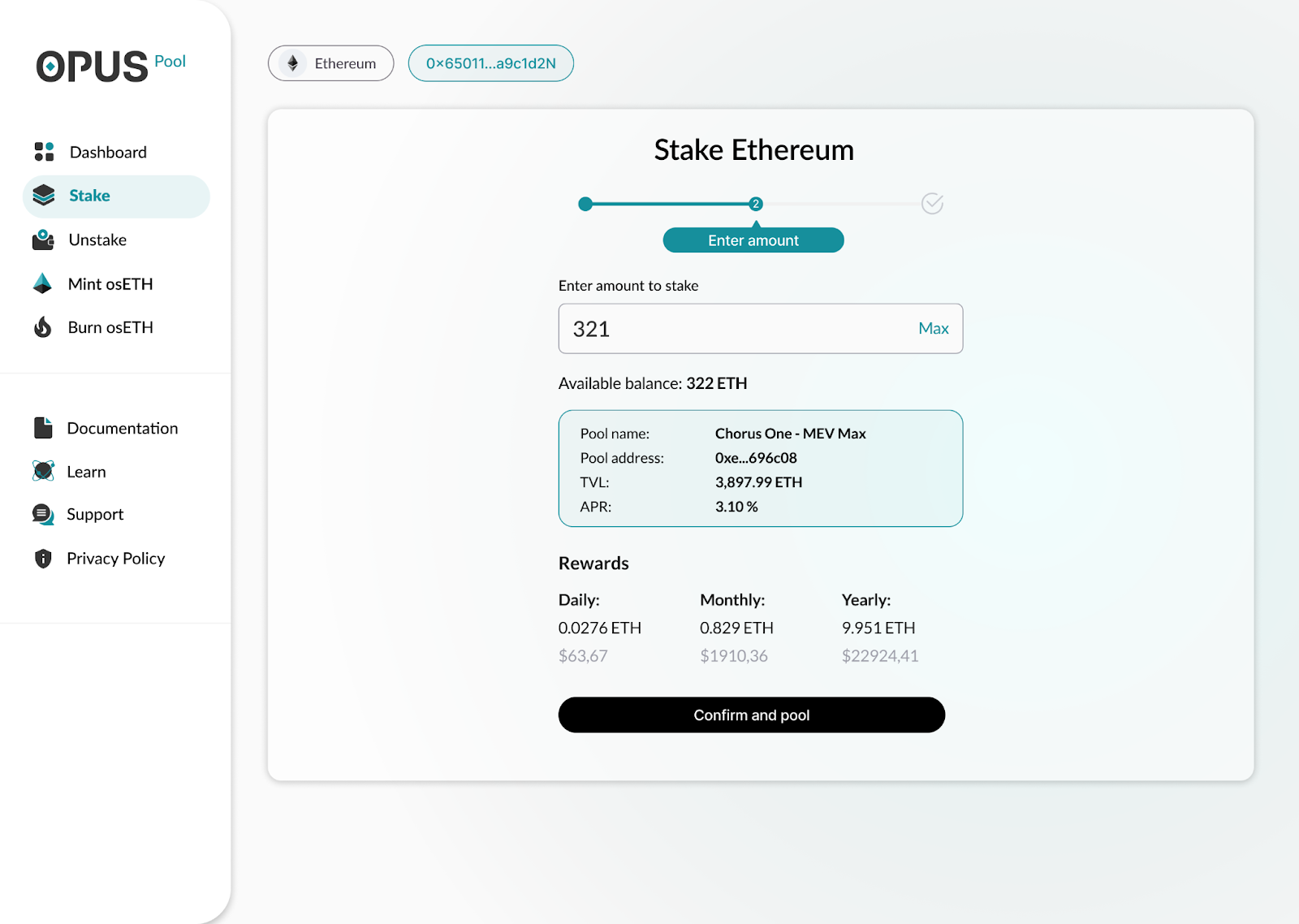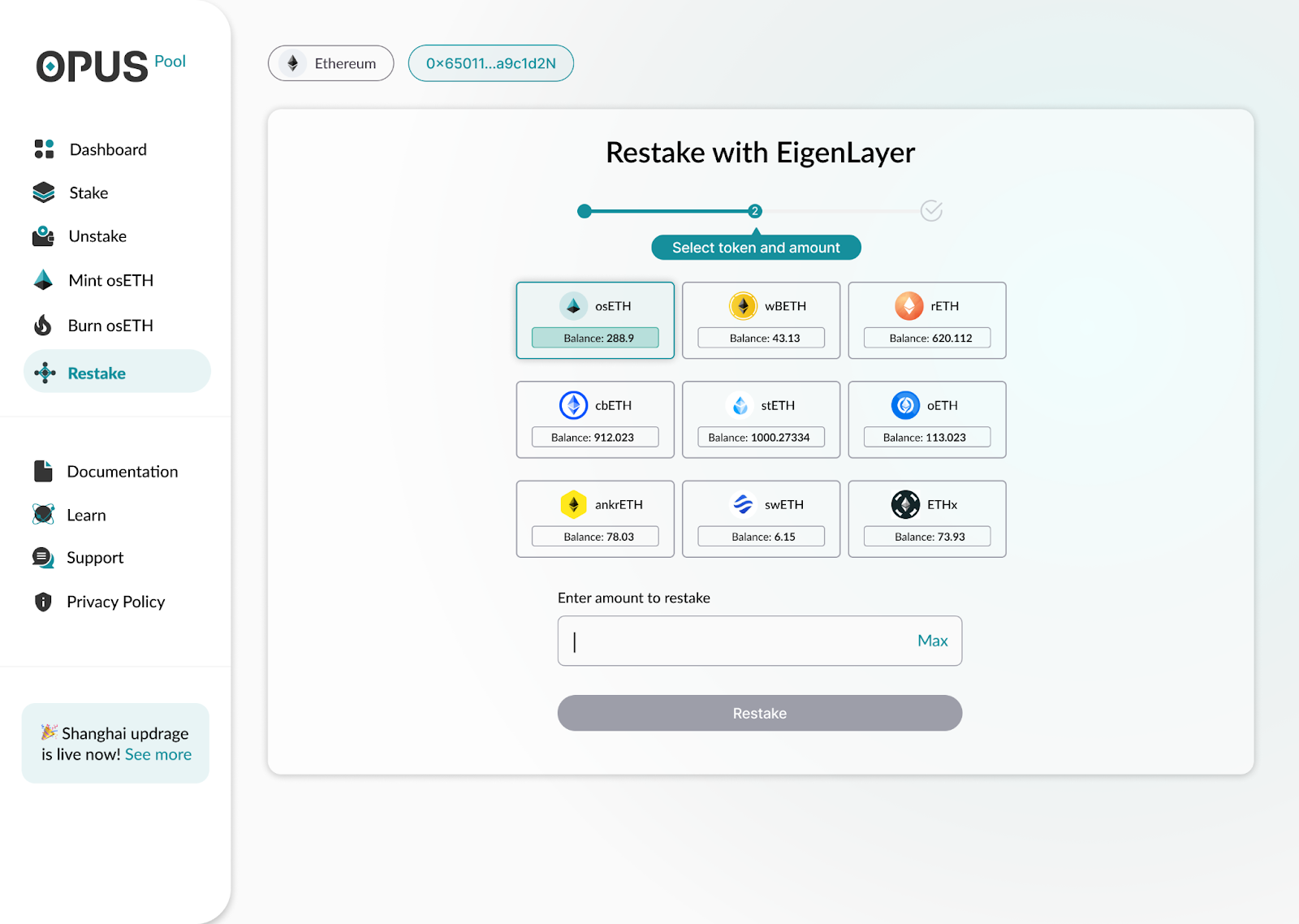
We’re thrilled to announce the launch of Chorus One's newest offering: the OPUS Pool. Until recently, a minimum threshold of 32 ETH was required for users to stake ETH on OPUS. But not anymore! Going forth, users may stake any amount of ETH directly via the OPUS Pool, mint osETH, and deposit into EigenLayer in one go.
Users have the extra benefit of depositing not only osETH, but any other accepted liquid staking tokens (currently, wbETH, rETH, cbETH, stETH, oETH , ankrETH , swETH, ETHx) into EigenLayer through the OPUS Pool!
Additionally, Institutional clients can leverage the OPUS SDK to integrate ETH staking into their offerings, providing their customers with all the benefits of the OPUS Pool seamlessly.
Start using OPUS Pool to stake ETH. Visit https://opus.chorus.one/pool/stake/
In this article, we’ll dive into why we launched the OPUS Pool, its benefits, how it’s different from existing liquid staking options, and how you can deposit various liquid staking tokens including osETH, wbETH, rETH, cbETH, stETH, oETH , ankrETH , swETH, ETHx into EigenLayer in a single move on the OPUS Pool.
Liquid staking is a mechanism that enhances traditional staking by introducing liquidity to staked assets. Unlike traditional staking, which necessitates locking up cryptocurrency to support a network’s operations and security, liquid staking allows participants to retain the fluidity of their assets. Through liquid staking, users stake their crypto with a liquid staking protocol and receive a token in return—this token symbolizes the staked amount and any accrued rewards or penalties.
The critical distinction lies in the usability of these new tokens: they can be freely traded or utilized within the DeFi ecosystem, thus allowing stakers to earn additional yields or use them as collateral in various financial protocols. This creates a dual advantage by enabling participation in network validation and security processes, akin to traditional staking, while simultaneously providing liquidity and opportunities to compound rewards in the broader DeFi space.
The OPUS Pool democratizes access to staking rewards by removing barriers such as minimum staking requirements and the need for technical infrastructure, making it an attractive option for a wider range of investors.
The OPUS platform, initially requiring a 32 ETH minimum for validator node operation, has evolved. Now, anyone can stake any amount of ETH (and even restake them) with Chorus One, using our OPUS Pool.
The OPUS Pool, powered by Stakewise smart contracts which have undergone rigorous auditing by esteemed security firms, not only facilitates greater participation in securing the network but also allows a wider range of Chorus One stakers to earn rewards and gain access to a suite of benefits, including top-tier MEV yields, low fees, and the assurance of enterprise-grade security, among others.
As previously mentioned, the OPUS Pool enables any user to stake any amount of ETH and receive rewards instantly. Additionally, users have the ability to mint osETH, a liquid staking derivative, and use it in DeFi or deposit into EigenLayer to gain additional rewards directly on OPUS Pool in one go.
The OPUS Pool sets itself apart from current liquid staking protocols by offering users the advantage of highly competitive staking fees. At just 5%, our fees are among the lowest in the industry, making it more accessible for a broader spectrum of users to stake their ETH and earn rewards.
As pioneers in MEV research, our latest ace, Adagio, is an MEV-Boost client that changes how transactions are handled for increased MEV capture.
Adagio's design allows for more efficient interactions with Ethereum’s transaction supply chain, directly enhancing MEV rewards for stakers. Fully integrated with OPUS Pool validators, Adagio ensures that anyone staking on OPUS Pool can benefit from these increased MEV rewards.
Want to learn more about Adagio and its mechanics? Read all about it here.
OPUS Pool offers a unique feature: users can deposit not only osETH minted through OPUS Pool but also liquid staking derivatives like osETH, stETH, cbETH, and rETH minted on other platforms, directly into EigenLayer.
This flexibility allows users to either mint osETH with OPUS Pool and deposit it into EigenLayer, or bring in any accepted liquid staking derivatives and seamlessly deposit them into EigenLayer in a single step.
Before we delve into the specifics of starting your staking journey with OPUS Pool, let's first understand what restaking is and how it's executed through EigenLayer.
Restaking in the context of Ethereum, as defined by Vitalik Buterin, is a process that allows Ethereum stakers to extend their staked assets' utility beyond the Ethereum network. It means that while your ETH remains staked on Ethereum, you can also leverage its staking power across other blockchain networks. This innovative approach enables new blockchain networks to utilize Ethereum's established validators and staked tokens for securing their trust systems.
Restaking offers stakers the flexibility to contribute to the security of multiple networks, potentially earning rewards, verifying trust, or engaging in blockchain events. It represents an evolution in blockchain participation, broadening the scope and impact of staked assets without requiring additional token allocation.
EigenLayer revolutionizes this concept by implementing smart contracts on Ethereum to facilitate restaking.
It creates a market-driven ecosystem where security is pooled and governed by supply and demand. Users that stake $ETH can opt-in to EigenLayer smart contracts to restake their $ETH and extend cryptoeconomic security to additional applications on the network. Part of EigenLayer’s potential, therefore, lies in its ability to aggregate and extend security through restaking and to validate new applications being built on top of Ethereum.
Actively Validated Services (AVS), essentially new projects or applications building on Ethereum, can tap into this pool, consuming security based on their needs while validators contribute at their discretion, weighing risks and rewards. This system negates the need for AVSs to establish their own validator networks, instead allowing them to utilize Ethereum’s existing security infrastructure.
For a more comprehensive overview of EigenLayer and how it addresses current challenges in Ethereum security, please read our latest blog.
Currently, there are two ways in which you can use the OPUS Pool. The first method involves minting your osETH through OPUS Pool and depositing it directly into EigenLayer, while the second method enables you to skip minting osETH and directly deposit any accept liquid staking tokens (osETH, cbETH, stETH, rETH) directly into EigenLayer on the OPUS Pool.
Both methods are made as simple as possible to enhance your staking experience, and can be completed in just 3 steps, as described below:
Step 1: Connect your wallet on the OPUS Pool page and deposit some ETH into the pool.

Step 2: Once deposited successfully, you can now mint your osETH in 1-click.

Step 3: Deposit your osETH into EigenLayer.

Step 1: Go to the OPUS Pool page, select Restake and connect your wallet

Step 2: Select token of your choice (osETH/stETH/cbETH/rETH ) and enter amount to Restake

Step 3: Deposit your tokens into EigenLayer

Our institutional customers may opt in to leverage the OPUS SDK to integrate ETH staking into their offerings, providing their customers with all the benefits of the OPUS Pool seamlessly.
This allows our institutional client’s customers to benefit from all the features offered by the OPUS Pool, including no minimum ETH required to stake, top tier-MEV yields, high rewards, and direct restaking with EigenLayer.
For a more detailed, step-by-step explanation of how you can stake your ETH and deposit into EigenLayer, please view our guide here.
To start staking on OPUS Pool, visit https://opus.chorus.one/pool/stake/
For institutions interested in learning more about the OPUS Pool SDK, please get in touch with our team at staking@chorus.one
Resources
A step-by-step guide to staking ETH on OPUS Pool
Restake with EigenLayer Seamlessly via Chorus One's OPUS Pool: A Detailed Guide
Learn more about Adagio, Chorus One’s pioneering Ethereum MEV-Boost client
MEV Max - Introducing Chorus One’s Liquid Staking Pool on Stakewise V3
Considerations on the Future of Ethereum Staking
Chorus One is one of the biggest institutional staking providers globally operating infrastructure for 50+ Proof-of-Stake networks including Ethereum, Cosmos, Solana, Avalanche, and Near amongst others. Since 2018, we have been at the forefront of the PoS industry and now offer easy enterprise-grade staking solutions, industry-leading research, and also invest in some of the most cutting-edge protocols through Chorus Ventures.